Shengli Zhou
GR-WiFi: A GNU Radio based WiFi Platform with Single-User and Multi-User MIMO Capability
Jan 10, 2025



Abstract:Since its first release, WiFi has been highly successful in providing wireless local area networks. The ever-evolving IEEE 802.11 standards continue to add new features to keep up with the trend of increasing numbers of mobile devices and the growth of Internet of Things (IoT) applications. Unfortunately, the lack of open-source IEEE 802.11 testbeds in the community limits the development and performance evaluation of those new features. Motivated by an existing popular open-source software-defined radio (SDR) package for single-user single-stream transmission based on the IEEE 802.11/a/g/p standard, in this paper we present GR-WiFi, an open-source package for single-user and multi-user multi-input multi-output (MIMO) transmissions based on 802.11n and 802.11ac standards. The distinct features of GR-WiFi include the support of parallel data streams to single or multiple users, and the compatible preamble processing to allow the co-existence of conventional, high-throughput (HT) and very-high-throughput (VHT) traffics. The performance of GR-WiFi is evaluated through both extensive simulation and real-world experiments.
Resonant Beam Communications: A New Design Paradigm and Challenges
Mar 25, 2024

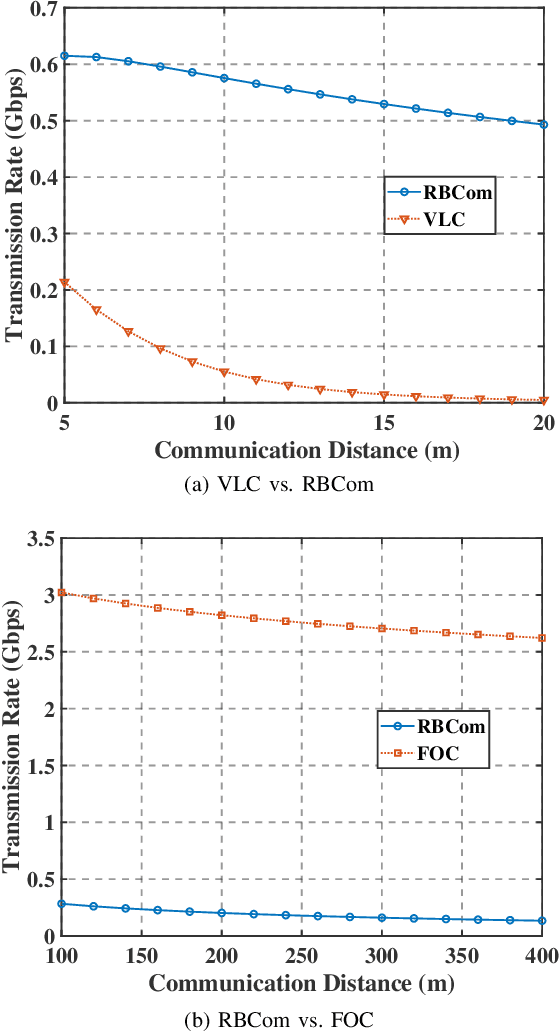

Abstract:Resonant beam communications (RBCom), which adopt oscillating photons between two separate retroreflectors for information transmission, exhibit potential advantages over other types of wireless optical communications (WOC). However, echo interference generated by the modulated beam reflected from the receiver affects the transmission of the desired information. To tackle this challenge, a synchronization-based point-to-point RBCom system is proposed to eliminate the echo interference, and the design for the transmitter and receiver is discussed. Subsequently, the performance of the proposed RBCom is evaluated and compared with that of visible light communications (VLC) and free space optical communications (FOC). Finally, future research directions are outlined and several implementation challenges of RBCom systems are highlighted.
Design and Performance of Resonant Beam Communications -- Part I: Quasi-Static Scenario
Mar 25, 2024



Abstract:This two-part paper studies a point-to-point resonant beam communication (RBCom) system, where two separately deployed retroreflectors are adopted to generate the resonant beam between the transmitter and the receiver, and analyzes the transmission rate of the considered system under both the quasi-static and mobile scenarios. Part I of this paper focuses on the quasi-static scenario where the locations of the transmitter and the receiver are relatively fixed. Specifically, we propose a new information-bearing scheme which adopts a synchronization-based amplitude modulation method to mitigate the echo interference caused by the reflected resonant beam. With this scheme, we show that the quasi-static RBCom channel is equivalent to a Markov channel and can be further simplified as an amplitude-constrained additive white Gaussian noise channel. Moreover, we develop an algorithm that jointly employs the bisection and exhaustive search to maximize its capacity upper and lower bounds. Finally, numerical results validate our analysis. Part II of this paper discusses the performance of the RBCom system under the mobile scenario.
Design and Performance of Resonant Beam Communications -- Part II: Mobile Scenario
Mar 25, 2024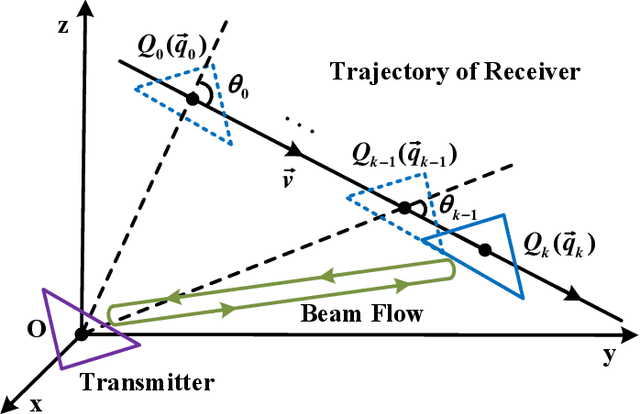
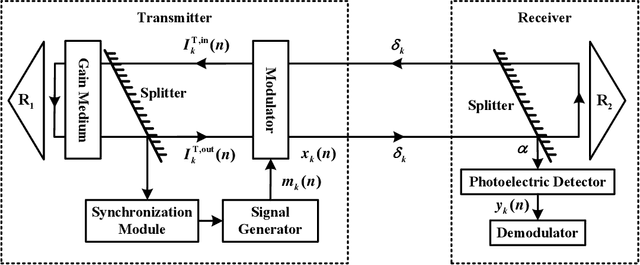
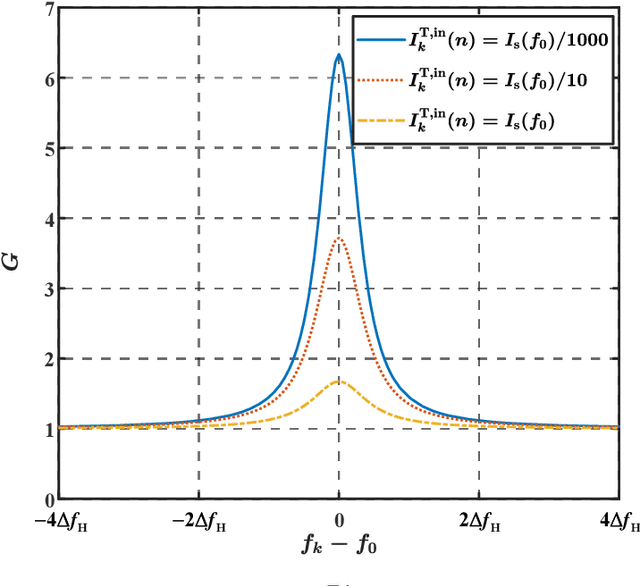
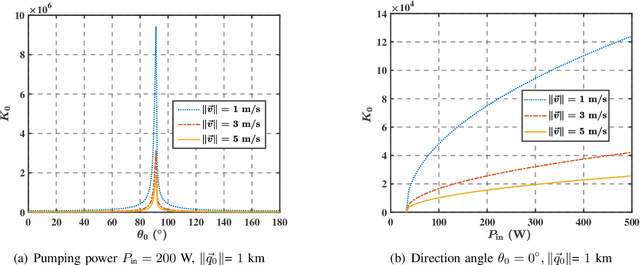
Abstract:This two-part paper focuses on the system design and performance analysis for a point-to-point resonant beam communication (RBCom) system under both the quasi-static and mobile scenarios. Part I of this paper proposes a synchronization-based information transmission scheme and derives the capacity upper and lower bounds for the quasi-static channel case. In Part II, we address the mobile scenario, where the receiver is in relative motion to the transmitter, and derive a mobile RBCom channel model that jointly considers the Doppler effect, channel variation, and echo interference. With the obtained channel model, we prove that the channel gain of the mobile RBCom decreases as the number of transmitted frames increases, and thus show that the considered mobile RBCom terminates after the transmitter sends a certain number of frames without frequency compensation. By deriving an upper bound on the number of successfully transmitted frames, we formulate the throughput maximization problem for the considered mobile RBCom system, and solve it via a sequential parametric convex approximation (SPCA) method. Finally, simulation results validate the analysis of our proposed method in some typical scenarios.
Binocular Localization Using Resonant Beam
Dec 02, 2022



Abstract:Locating mobile devices precisely in indoor scenarios is a challenging task because of the signal diffraction and reflection in complicated environments. One vital cause deteriorating the localization performance is the inevitable power dissipation along the propagation path of localization signals. In this paper, we propose a high-accuracy localization scheme based on the resonant beam system (RBS) and the binocular vision, i.e., binocular based resonant beam localization (BRBL). The BRBL system utilizes the energy-concentrated and self-aligned transmission of RBS to realize high-efficiency signal propagation and self-positioning for the target. The binocular method is combined with RBS to obtain the three-dimensional (3-D) coordinates of the target for the first time. To exhibit the localization mechanism, we first elaborate on the binocular localization model, including the resonant beam transmission analysis and the geometric derivation of the binocular method with RBS. Then, we establish the power model of RBS, and the signal and noise models of beam spot imaging, respectively, to analyse the performance of the BRBL system. Finally, the numerical results show an outstanding performance of centimeter level accuracy (i.e., $<5\mathrm{cm}$ in $0.4\mathrm{m}$ width and $0.4\mathrm{m}$ length effective range at $1\mathrm{m}$ vertical distance, $<13\mathrm{cm}$ in $0.6\mathrm{m}$ width and $0.6\mathrm{m}$ length effective range at $2\mathrm{m}$ vertical distance), which applies to indoor scenarios.
Time-Domain Analysis for Resonant Beam Charging and Communications With Delay-Divide Demodulation
Mar 02, 2022
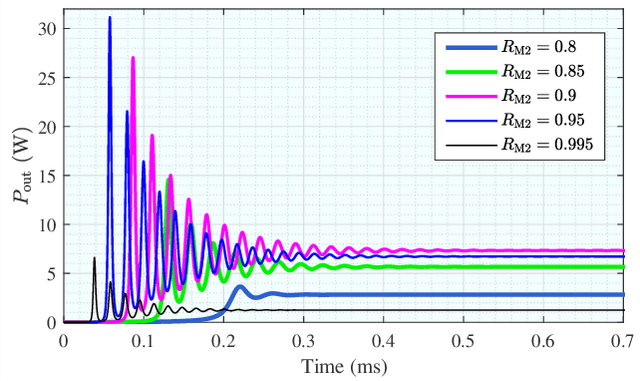
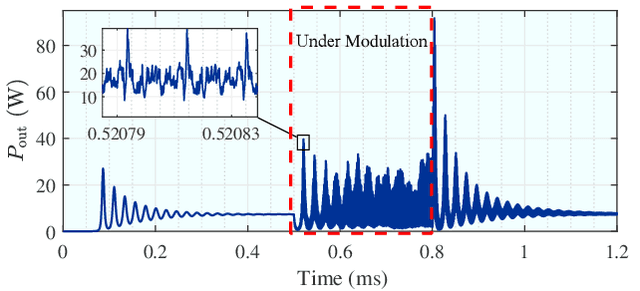
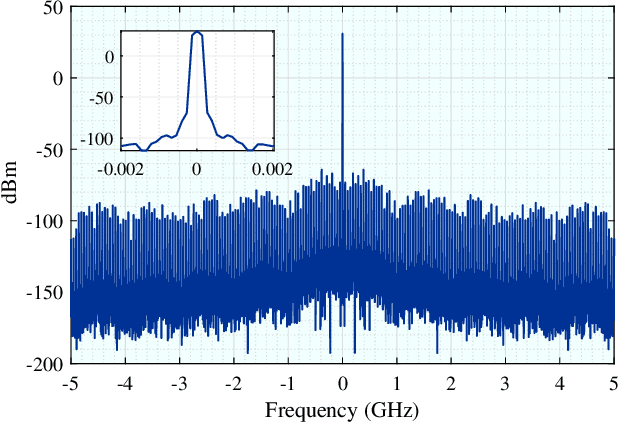
Abstract:Laser has unique advantages such as abundant spectrum resources and low propagation divergence in wireless charging and wireless communications, compared with radio frequency. Resonant beams, as a kind of intra-cavity laser beams, have been proposed as the carrier of wireless charging and communication, as it has unique features including high power, intrinsic safety, and self-aligned mobility. However, this system has problems such as intra-cavity echo interference and power fluctuation. To study the time-domain behavior of the resonant beam system, we create a simulation algorithm by discretizing the laser rate equations which model the dynamics of the excited atom density in the gain medium and the photon density in the cavity. The simulation results are in good agreement with theoretical calculation. We also propose a delay-divide demodulation method to address the echo interference issue, and use the simulation algorithm to verify its feasibility. The results show that the resonant beam charging and communication system with the proposed demodulator is feasible and performs well. The analysis in this work also helps researchers to deeply understand the behavior of the resonant beam system.
Optimization of A Mobile Optical SWIPT System With Asymmetric Spatially Separated Laser Resonator
Oct 09, 2021



Abstract:High-power and high-capacity simultaneous wireless information and power transfer (SWIPT) becomes more and more important with the development of Internet of Things technologies. Optical SWIPT, also known as simultaneous light information and power transfer (SLIPT), has unique advantages such as abundant spectrum resources and low propagation divergence, compared with RF technologies. However, optical SWIPT faces many challenges in beam steering and receiver positioning/tracking. Resonant beams generated by spatially separated laser resonators (SSLR) have many advantages, including high power, self-aligned mobility, and intrinsic safety. It has been proposed as the carrier of wireless charging and communication. Using resonant beams, mobile electronic devices can be remotely charged and supported with high-rate data transfer. In this paper, we propose a mobile optical SWIPT system based on asymmetric SSLR and present the system optimization procedure. We also determine the boundary of the achievable charging power and communication capacity, and discuss the trade-off between power transfer and information transfer. Numerical results show that the charging power of the optimized asymmetric system is much higher than that of the symmetric system in the previous work, and meanwhile, the channel capacity is kept almost unchanged.
High-Power and High-Capacity Mobile Optical SWIPT
Jul 26, 2021



Abstract:The increasing demands of power supply and data rate for mobile devices promote the research of simultaneous information and power transfer (SWIPT). Optical SWIPT, as known as simultaneous light information and power transfer (SLIPT), can provide high-capacity communication and high-power charging. However, light emitting diodes (LEDs)-based SLIPT technologies have low efficiency due to energy dissipation over the air. Laser-based SLIPT technologies face the challenge in mobility, as it needs accurate positioning, fast beam steering, and real-time tracking. In this paper, we propose a mobile SLIPT scheme based on spatially separated laser resonator (SSLR) and intra-cavity second harmonic generation (SHG). The power and data are transferred via separated frequencies, while they share the same self-aligned resonant beam path, without the needs of receiver positioning and beam steering. We establish the analysis model of the resonant beam power and its second harmonic power. We also evaluate the system performance on deliverable power and channel capacity. Numerical results show that the proposed system can achieve watt-level battery charging power and above 20-bit/s/Hz communication capacity over 8-m distance, which satisfies the requirements of most indoor mobile devices.
Mobile Optical Communications Using Second Harmonic of Intra-Cavity Laser
Jun 21, 2021



Abstract:Optical wireless communication (OWC) meets the demands of the future six-generation mobile network (6G) as it operates at several hundreds of Terahertz and has the potential to enable data rate in the order of Tbps. However, most beam-steering OWC technologies require high-accuracy positioning and high-speed control. Resonant beam communication (RBCom), as one kind of non-positioning OWC technologies, has been proposed for high-rate mobile communications. The mobility of RBCom relies on its self-alignment characteristic where no positioning is required. In a previous study, an external-cavity second-harmonic-generation (SHG) RBCom system has been proposed for eliminating the echo interference inside the resonator. However, its energy conversion efficiency and complexity are of concern. In this paper, we propose an intra-cavity SHG RBCom system to simplify the system design and improve the energy conversion efficiency. We elaborate the system structure and establish an analytical model. Numerical results show that the energy consumption of the proposed intra-cavity design is reduced to reach the same level of channel capacity at the receiver compared with the external-cavity one.
 Add to Chrome
Add to Chrome Add to Firefox
Add to Firefox Add to Edge
Add to Edge